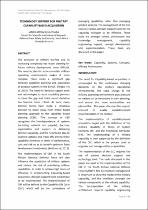JavaScript is disabled for your browser. Some features of this site may not work without it.
- ResearchSpace
- →
- Research Publications/Outputs
- →
- Conference Publications
- →
- View Item
| dc.contributor.author |
Thaba, Mphahlela

|
|
| dc.date.accessioned | 2017-08-22T13:07:52Z | |
| dc.date.available | 2017-08-22T13:07:52Z | |
| dc.date.issued | 2017-05 | |
| dc.identifier.citation | Thaba, M. 2017. Technology support for military capability based acquisition. 26th International Association for Management of Technology Conference - IAMOT 2017, Vienna, Austria, 25 May 2017 | en_US |
| dc.identifier.uri | http://bestevent.management/event/7/session/18/contribution/180.pdf | |
| dc.identifier.uri | http://hdl.handle.net/10204/9450 | |
| dc.description | 26th International Association for Management of Technology Conference - IAMOT 2017, Vienna, Austria, 25 May 2017 | en_US |
| dc.description.abstract | The evolution of military warfare and its increasing complexity has made planning for future military deployments more difficult. The need to plan for more uncertain military operating environments makes it more complex. There exists a significant gap between capability planning and acquisition of product systems in the SANDF. (Thaba J et al, 2015). The need for decision support tools and technologies to assist capability planners to close this gap and make sound decisions has become more critical. As such, many defence forces have made a conscious decision to move away from threat based planning approach to the capability based planning (CBP). " The concept of CBP recognises the interdependence of systems (including material and people), doctrine, organisation and support in delivering defence capability, and the need to be able to examine options and trade-offs among these capability elements in terms of performance, cost and risk so as to identify optimum force development investments. (Botha et al, 2012) The implementation of CBP in the South African National Defence Force will also influence the acquisition of military systems and reduce the risk of prioritising military capabilities. In order to achieve high levels of efficiency in implementing Capability-based acquisition, decision support tools would have to be implemented. The implementation of CBP will be defined by the Capability Life Cycle (CLC), which will be the cornerstone of managing capabilities rather than managing product systems. The management of the CLC requires various decision support tools for the capability manager to be effective. These tools are amongst others, architecture and knowledge management, capability engineering support, concept development and experimentation. These tools are discussed in this paper. | en_US |
| dc.language.iso | en | en_US |
| dc.relation.ispartofseries | Worklist;19264 | |
| dc.subject | Capability | en_US |
| dc.subject | Systems | en_US |
| dc.subject | Concepts | en_US |
| dc.subject | Military Architecture | en_US |
| dc.title | Technology support for military capability based acquisition | en_US |
| dc.type | Conference Presentation | en_US |
| dc.identifier.apacitation | Thaba, M. (2017). Technology support for military capability based acquisition. http://hdl.handle.net/10204/9450 | en_ZA |
| dc.identifier.chicagocitation | Thaba, Mphahlela. "Technology support for military capability based acquisition." (2017): http://hdl.handle.net/10204/9450 | en_ZA |
| dc.identifier.vancouvercitation | Thaba M, Technology support for military capability based acquisition; 2017. http://hdl.handle.net/10204/9450 . | en_ZA |
| dc.identifier.ris | TY - Conference Presentation AU - Thaba, Mphahlela AB - The evolution of military warfare and its increasing complexity has made planning for future military deployments more difficult. The need to plan for more uncertain military operating environments makes it more complex. There exists a significant gap between capability planning and acquisition of product systems in the SANDF. (Thaba J et al, 2015). The need for decision support tools and technologies to assist capability planners to close this gap and make sound decisions has become more critical. As such, many defence forces have made a conscious decision to move away from threat based planning approach to the capability based planning (CBP). " The concept of CBP recognises the interdependence of systems (including material and people), doctrine, organisation and support in delivering defence capability, and the need to be able to examine options and trade-offs among these capability elements in terms of performance, cost and risk so as to identify optimum force development investments. (Botha et al, 2012) The implementation of CBP in the South African National Defence Force will also influence the acquisition of military systems and reduce the risk of prioritising military capabilities. In order to achieve high levels of efficiency in implementing Capability-based acquisition, decision support tools would have to be implemented. The implementation of CBP will be defined by the Capability Life Cycle (CLC), which will be the cornerstone of managing capabilities rather than managing product systems. The management of the CLC requires various decision support tools for the capability manager to be effective. These tools are amongst others, architecture and knowledge management, capability engineering support, concept development and experimentation. These tools are discussed in this paper. DA - 2017-05 DB - ResearchSpace DP - CSIR KW - Capability KW - Systems KW - Concepts KW - Military Architecture LK - https://researchspace.csir.co.za PY - 2017 T1 - Technology support for military capability based acquisition TI - Technology support for military capability based acquisition UR - http://hdl.handle.net/10204/9450 ER - | en_ZA |






